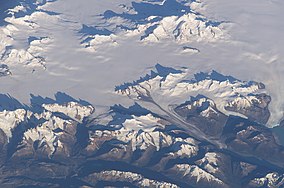Bernardo O'Higgins National Park
| Bernardo O'Higgins National Park | |
|---|---|
 Southern Patagonian Ice Field | |
| Location | Aysén del General Carlos Ibáñez del Campo Region-Magallanes Region, Chile |
| Coordinates | 50°0′S 74°00′W / 50.000°S 74.000°W |
| Area | 3,525,901 ha (8,712,691 acres)[1] |
| Established | July 22, 1969 |
| Visitors | 35,964[2] (in 2016) |
| Governing body | Corporación Nacional Forestal |
Bernardo O'Higgins National Park (Spanish pronunciation: [beɾˈnaɾðo oˈxiɣins]) is the largest of the protected areas in Chile, covering an area of 3,525,901 ha (8,712,691 acres),[1] in both the Aysén and Magallanes and Antártica Chilena regions.[3] Management of this and other national parks in Chile is entrusted to the Corporación Nacional Forestal (CONAF).[4] The park is named after General Bernardo O'Higgins, the first head of state of the Republic of Chile. Los Glaciares National Park (Argentina) and Torres del Paine National Park are its neighbours to the east, Laguna San Rafael National Park is located to the north, the Alacalufes National Reserve to the southwest, and the Katalalixar National Reserve to the northwest.
History
The earliest occupants of the area were the Alacaluf people.
In 1830, the then-Captain Phillip Parker King on board HMS Beagle visited the Eyre Fjord.[5]
In June 2007, it was announced that between March and May 2007 all the water within a glacial lake located within the park had disappeared, leaving behind a 100-foot-deep crater. Only some blocks of ice, previously floating on the lake, remained behind on the crater floor. In July 2007, scientists were able to draw the preliminary conclusion that the disappearance occurred as a result of climate change.[6]
In 2014 the natural sites Chaltén Mountain Range and Pío XI Glacier were created as subdivitions of the natural park.[7]
Geography
The park is located approximately between 48° and 51° 38' South Latitude (between the Baker Channel and the northern part of the Fjord of the Mountains. The east-central area of the park is subject to a territorial dispute between Chile and Argentina. The highest summit is the Lautaro volcano at 3,607 m (11,834 ft). Other summits include the Mount Fitz Roy, the Circo de los Altares,[8] the Cerro Torre and the Cerro Riso Patrón. The elevations are lower in the southern part of the park, but the scenery is still spectacular. The highlight of this zone is Mount Balmaceda at 2,035 m (6,677 ft), beautified by the glaciers Balmaceda and Serrano.
There are no large rivers on the park coast, but the narrow fjords penetrate deeply into the mountains and bring away the drainage of their ice-capped, storm-swept elevations.
Geology
Glaciers

The park includes a great part of the Southern Patagonian Ice Field. One of its main attractions is the Glacier Pío XI, from which enormous ice blocks periodically spall. The Pío XI glacier is the largest glacier in the southern hemisphere outside of Antarctica, covering an area of 1,265 km2 (488 sq mi), and has advanced over the past 50 years by more than 10 km (6 mi); one of its tongues measures approximately 6 km (4 mi). The ice face of the glacier is approximately 75 m (246 ft) in height (about 30 floors of a conventional building) and the falling ice generates waves exceeding 10 m (33 ft) in height; significant enough to rock larger vessels. Other outlet glaciers are Chico, O'Higgins, Jorge Montt, Bernardo, Témpano, Occidental, Greve, Penguin and Amalia.[5]
Internal natural sites
On February 27, 2014, Chile's National Forestry Corporation created the Chaltén Mountain Range Natural Site by Resolution No. 74, which covers the Chilean side of Mount Fitz Roy and the surrounding mountain range. The same decree also created the Pío XI Glacier Natural Site.[9]
| Photo | Name | Year | Region(s) | Province(es) | Area (Ha) |
|---|---|---|---|---|---|
 |
Chaltén Mountain Range Natural Site | 2014 | Última Esperanza | 768 | |
 |
Pío XI Glacier Natural Site | 2014 | Última Esperanza |
Biology
The area of the park corresponds to the Magellanic subpolar forests ecoregion. The forests are made up of several trees species, including Nothofagus betuloides, Nothofagus pumilio, Nothofagus antarctica and Drimys winteri.
The park is one of the last refuges for the Chilean huemul. In this also can be found species such as Andean condor, marine otter and cormorant.
Tourism
Because of its rugged geography and the remoteness of the area, the tourism in the park has been scarcely developed. It is only accessible by boat or helicopter. The glaciers located at the head of Última Esperanza Sound and the glacier Pío XI are the most visited areas of the park. The main gateways for visitors to the park are Puerto Natales, Villa O'Higgins, Caleta Tortel and Puerto Edén. Sea kayaking is a popular activity in the park.
See also
- Chaltén Mountain Range Natural Site
- Base General Bernardo O'Higgins Riquelme
- Wellington Island
- Zona Austral
- Guayaneco Archipelago
- O'Higgins Lake
References
- ^ a b "National Parks of Chile". CONAF. Retrieved 2 April 2017.
- ^ "Visitor Statistics" (PDF). National Forest Corporation (Chile). 31 January 2017. p. 3. Retrieved 2 April 2017.
- ^ "Bernardo O'Higgins National Park". Archived from the original on 28 May 2010. Retrieved 18 February 2010.
- ^ "Parque Nacional Bernardo O'Higgins". Corporacion Nacional Forestal. Retrieved 2 April 2017.
- ^ a b USGS. "P 1386-I -- Chile and Argentina - Wet Andes". Retrieved 2007-06-24.
- ^ NBC News: Climate Change Likely Culprit in Vanishing Lake
- ^ "RESOLUTION NOº:74/2014" (PDF) (in Spanish). Corporación Nacional Forestal. February 27, 2014. Retrieved 6 February 2023.
- ^ "¿Nuevo conflicto con Chile? Un domo de montaña en los Hielos Continentales amenaza con renovar tensiones" (in Spanish). La Nación. September 10, 2021.
- ^ "RESOLUCIÓN NOº:74/2014" (PDF) (in Spanish). Corporación Nacional Forestal. February 27, 2014. Retrieved February 6, 2023.
